Star Voting (SV)
STAR Voting requires constituents to score each PN from zero to five stars, with zero being used for PNs that constituents do not want to be elected and 5 being for those PNs that the constituent supports most strongly. After this, stars from all of the PNs are added up with the winner being the PNs with the most stars. As STAR stands for Score Then Automatic Runoff, there would usually be a runoff process after the ballot tabulation to decide the single winner. However, as the National Party intends to simply pick one of the two candidates in the Debate Round, the runoff is not necessary.
Practical Positives
Like Approval Voting, STAR Voting’s simplicity is a major pro. Rating using a 5 star system is something we do frequently when we rate restaurants, movies or anything else that requires preference-based ratings. Especially considering the fact that they would only have to rate 4 PN’s, constituents would have an extremely easy time adapting to the use of this system.
Analytical Positives
Compared to the other methods examined in this paper, STAR offers little to no incentive for constituents to select their favorite PNs strategically (Wolk et al, 2023).
Figure 3
The above graph shows the VSE of different voting methods when voters are honest compared to when they consider the electoral viability of PNs. As can be easily seen, the difference between the VSE of honest and viability aware constituents in STAR is extremely minimal. Moreover, the VSE of honest STAR voters is higher than any other honest VSE and that of viability aware voters is second only to Minimax.
This lack of incentive to vote strategically can be extended to many other strategic methods. For instance, if one were to look back at Figure 2, it would be easy to spot that all of the most harmful voting strategies (burial, bullet and favorite betrayal) are very strongly disincentivized by STAR.
Figure 4
Furthermore, moving past PVSI, Ogren (2025) measured broad VSE using over 1,000,000 different simulations, with results being shown in Figure 4. As can be seen, although the VSE of all methods examined in this paper is relatively high, STAR is the highest, with little to no difference in the VSE when the number of candidates is increased or decreased. This suggests that voters will almost always be satisfied with the results of a STAR selection process.
Practical Negatives
Having only been invented in 2014, the major practical negative with STAR voting is that it has never been used in any major public election. Therefore, if the National Party were to choose it as the ideal method for its second round of nominee selection, it may run into unforeseen issues that could damage or derail the selection process. While this is only hypothetical and there’s no way of knowing if the NP will run into said issues, it’s still useful to consider.
Analytical Negatives
The biggest problem with STAR voting has to do with the fact that it is a “majoritarian” election method. Primarily, this has to do with a lack of minority representation in areas that use the methods. Theoretically, if a particular voting bloc took up 60% of the electorate, they would be able to choose both Debate Round PNs without any say from the minority. That said, as previously mentioned in Bardal et al (2025), such voting blocs tend to be hard to find in public elections. All things considered, while the possibility of a tyrannical majority is more likely in naturally uncompetitive districts, it is still important to consider.



